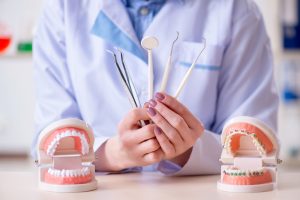Please note we may not offer every orthodontic treatment listed. Call our office for more information.
What Are Pediatric Orthodontics?
Pediatric orthodontics, also known as children’s orthodontics, is a specialized area of orthodontics that focuses on the diagnosis, prevention, and treatment of dental and facial irregularities in children. Pediatric orthodontists are dental specialists who have received additional training and experience in treating children and adolescents.
They work closely with pediatric dentists and other dental specialists to provide comprehensive care for children’s oral health. Early orthodontic evaluation and treatment can help prevent more severe problems from developing later in life.
Call (715) 646-2161 to schedule an appointment with the top dentist in Centuria, WI, Dr. Vargas.
Orthodontic Evaluation
The American Association of Orthodontists recommends that children have their first orthodontic evaluation by seven. Several factors indicate a need for orthodontic evaluation in children. Some of these factors include:
- Difficulty chewing
- Mouth breathing
- Thumb-sucking
- Crowded or overlapping teeth
During the evaluation, the pediatric orthodontist will conduct a clinical exam, take X-rays, and make impressions of the child’s teeth. These tools help identify common orthodontic problems, such as crowding, spacing, overbite, and underbite. Malocclusions are classified into Class I, Class II, and Class III.
Orthodontic Treatments for a Beautiful Smile
Braces
Braces are the most common orthodontic treatment for children. They consist of brackets, wires, and bands that apply gentle pressure to the teeth, gradually moving them into the desired position. The brackets can be made of metal, ceramic, or plastic, and the wires can be made of different materials, including nickel-titanium, copper, or stainless steel.
The orthodontist will adjust the braces periodically to ensure that the teeth are moving correctly. Braces are typically worn for one to three years, depending on the severity of the malocclusion.
Clear Aligners
 Clear aligners are an alternative to traditional braces that use a series of removable plastic trays to move the teeth gradually. Clear aligners are nearly invisible, making them a popular choice for teenagers self-conscious about their appearance.
Clear aligners are an alternative to traditional braces that use a series of removable plastic trays to move the teeth gradually. Clear aligners are nearly invisible, making them a popular choice for teenagers self-conscious about their appearance.
Clear aligners are customized for each patient and designed to move the teeth in specific stages. The orthodontist will provide a new set of aligners every few weeks, and the treatment typically lasts between six to 18 months.
Expanders
Expanders are appliances that widen the upper jaw to create more space for the teeth to grow. They’re typically used in patients who have a narrow palate or crowded teeth. The expander is attached to the upper molars and applies gentle pressure to the upper jaw. Over time, the jaw widens, creating more space for the healthy teeth.
The orthodontist will adjust the expander periodically to ensure that it’s working correctly. The treatment typically lasts six to 12 months, depending on the severity of the malocclusion.
Other Appliances
In addition to braces, clear aligners, and expanders, there are other appliances that orthodontists may use to correct specific orthodontic problems and obtain a healthy smile. These include:
- Headgear: A device that attaches to the braces and applies pressure to the upper teeth and jaw to correct overbite or underbite.
- Herbst Appliance: A device that attaches to the molars and moves the lower jaw forward to correct an overbite.
- Palatal Lift Appliance: An appliance that lifts the soft palate to improve speech and breathing in children with a cleft palate or other oral abnormalities.
- Retainers: Appliances that hold the teeth in their corrected positions after orthodontic treatment. Retainers can be removable or fixed and are typically worn for several months to years.
Orthodontic Treatment Phases
 Orthodontic treatment is planned based on growth and development, and the orthodontist may also use appliances to modify jaw growth. There are three primary phases of orthodontic treatment:
Orthodontic treatment is planned based on growth and development, and the orthodontist may also use appliances to modify jaw growth. There are three primary phases of orthodontic treatment:
- Early treatment is done between the ages of seven and 11, and it aims to intercept potential orthodontic issues before they worsen.
- Interceptive treatment is done between the ages of 11 and 15, and it addresses existing problems before they become severe.
- Comprehensive treatment, also called full treatment, involves correcting all orthodontic issues, including alignment, bite, and jaw position.
Care and Maintenance
Orthodontic hygiene and care for children are essential. Children with braces should brush their teeth twice a day, floss daily, and use a fluoride rinse. Regular dental check-ups are also necessary during orthodontic treatment. The orthodontist will monitor progress and make necessary adjustments to the appliances.
Potential risks and complications associated with orthodontic treatment include tooth decay, gum disease, and damage to the appliances. Parents and caregivers should be aware of these risks and take necessary precautions.
Frequently Asked Questions
Yes, children can still play sports while undergoing orthodontic treatment. However, they should wear a mouthguard to protect their teeth and braces or other appliances from damage.
Orthodontic treatment can cause discomfort, particularly after the braces or other appliances are placed or adjusted. However, any discomfort is usually mild and can be managed with over-the-counter pain relievers.
Children should contact their orthodontist immediately if they experience any problems with their braces or other appliances, such as a loose bracket or wire. The orthodontist can provide instructions on how to address the issue and prevent further damage.
